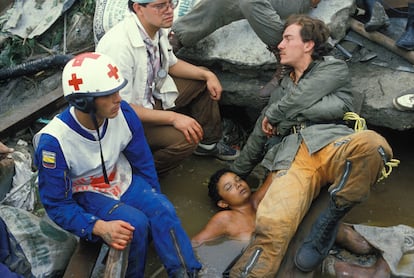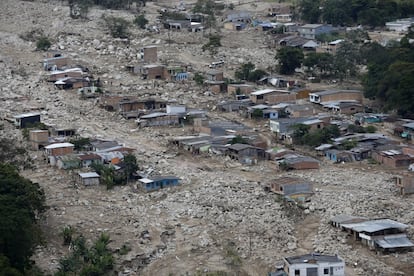When Gloria Cortés began studying geology, she did not think about the huge volcano that was located near her home in the Colombian city of Manizales. It was the beginning of 1984 and the Nevado del Ruiz was a tourist destination to enjoy the snow, “a sleeping lion” that had had its last eruptions in the 16th and 19th centuries. He chose his career because an academic visited his chemistry class at school and talked about fossils, the world of oil and the journeys they would face. A year and a half later, on November 13, 1985, the eruption of Ruiz caused the greatest natural tragedy in the history of Colombia. He killed approximately 25,000 people, including Cortés’ best friend, and buried the city of Armero. The student and many of her classmates abandoned their interest in hydrocarbons and began studying volcanoes to prevent further tragedies.
Ruiz’s first warning sign, more than a century after its last eruption, was an earthquake in December 1984. Cortés says some climbers began to warn their teachers of striking changes at the top of the snow-capped mountain: yellowish gases, changes in the color of the snow, loud noises. “We started receiving important visits from foreign geologists, who said we needed to start monitoring and preparing a threat map,” Cortés says in a video call from the Manizales Volcanological and Seismological Observatory, about thirty kilometers from the snow-capped peak. In July 1985, authorities installed four earthquake meters on the volcano. In September, concern increased after a first eruption which, although small and without expulsion of magma, covered the city of Manizales in ash. A few weeks later a map was published identifying the risk areas, among which Armero was located.
There were major limitations. The four sensors installed, for example, did not have a telemetry system that sent information in real time: the seismic waves were recorded on cards which then had to be transported to Manizales, about 50 kilometers away on roads and highways, for analysis. The arrival of the transmission means was expected only a week before the eruption, but the commission in charge “was interrupted” due to the capture and reconquest of the Palace of Justice, the other tragedy that shocked Colombia in November 1985. There weren’t even enough experts. “We didn’t even know the word ‘volcanology,’” Cortés recalls.
However, the geologist claims that a lot has been achieved despite the limitations. “There were cutting-edge technologies and pioneering people working for months, without hours, early in the morning, in a country that didn’t have the right structure. It was frustrating to see that effort end with what it did,” he assesses. For her the main problem was not scientific, but social: “There was no time” to convince the communities in the area that the threat was real and that they had to move. “The elders said, ‘This has never happened in my life, so it won’t happen again,’ without understanding that 80 years is nothing in the experience of a volcano,” he comments.
When the volcano erupted at 9:08 p.m. On November 13, 1985, the only warning came from a journalist: at 10.30pm, he said on the radio that he had received warnings from highlanders about mud and rock avalanches barreling down towards Armero, on the mountainside opposite Manizales. The rains hindered the transmission and few heard it. An hour later, more than 22,000 people out of a total of 30,000 living in the city of Tolima were buried, and another 3,000 died in the neighboring department of Caldas. The Armerites never knew that a quarter of an hour was enough to reach the hills and save themselves.
After the tragedy
Geologists, Colombian and foreign, have studied the Armero tragedy as a demonstration of the impact that snow-capped mountains can have: Ruiz is 5,300 meters above sea level. “At volcanoes with summits covered in ice and snow, catastrophic lahars (volcanic mudflows) can occur due to relatively small eruptions,” concludes a paper published in 1990 in Journal of volcanology and geothermal research. The Nov. 13 eruption scored just 3 out of 8 on the Volcanic Explosivity Index, but the interaction of the hot material with glaciers produced huge amounts of water. That flow rushed along the rivers and swept away everything in its path. According to the article, the eruption caused “the deadliest lahars ever recorded.”

Colombia has started to take the risks of volcanoes seriously: there are 25 active ones. Lina Marcela Castaño, coordinator of the Manizales Observatory, comments that Ruiz has gone from being “an element of admiration for its beauty” to a formation to be monitored. “Today there are 75 sensors. Not only to measure earthquakes, but also gases, magnetic signals, acoustics, slope inclinations,” he explains from Manizales, where he works with Cortés. After the creation of the observatory he directed in 1986, the Pasto observatory was created in 1989 and the Popayán observatory in 1993. More than a hundred professionals study the history of the formations, interpret sensor data and raise awareness in the communities. They classify volcanoes into risk categories: green (normal), yellow (low), orange (moderate) and red (high). There are currently 10 in yellow and none at the top level.
The two geologists and their colleague Julián Ceballos point out that awareness of the need to pay attention to warning signs and evacuate has also strengthened. One of the positive references is the case of the Pinatubo volcano in the Philippines, which had a level 5 eruption in 1991. Geologists say authorities persuaded countless at-risk people to evacuate after showing them videos of the 25,000 deaths in Armero. Although the eruption was the second most powerful of the 20th century, only 847 people died, compared with around 200,000 people displaced. Another case is that of Nevado del Huila in Colombia, where several huge lahars occurred between 2007 and 2008. “The indigenous community understood the impact and was instrumental in the evacuation of approximately 6,000 people,” says Ceballos.

However, there are also difficulties. The first is that volcanic eruptions compete in the interests of communities with other more frequent phenomena, such as floods, earthquakes and landslides. It is more difficult to convince affected people to evacuate and lose their sources of livelihood when the phenomenon occurs every decades or even centuries. Likewise, every year the state must be convinced of the need to maintain funding for the observatories. “Fortunately this year it was possible, but we are always exposed to non-renewal of contracts,” explains coordinator Castaño. “The last major purchase of equipment took place in 2010. Only now, 15 years later, will we start to renew it,” he adds.
The other catastrophes
While not volcanic, other predicted catastrophes have rocked Colombia in recent decades. In 2010, a landslide buried Gramalote, in Norte de Santander. The operation was slow compared to Armero – it took two days – and all 3,300 residents were evacuated in time. There were no deaths, but there was strong criticism because for years warnings that the city was in a risk zone and needed to be relocated had been ignored. Seven years later, a series of rains caused a sudden avalanche of land in the city of Mocoa, endangered by the instability of the mountains and the confluence of rivers. More than 330 people died and another 400 were injured.

The director of the Colombian Geological Survey, Julio Fierro, acknowledges in a video call that there are cases in which “history repeats itself”. He comments that scientific information “has not been used” in Mocoa and underlines that he is worried about the repopulation of the area, which is also happening around the Nevado del Ruiz. According to him, there are “very complex dynamics” that surpass the state: armed groups that move people to risky places, municipal authorities that allow legal agreements, private companies that offer services such as energy in these areas. He states, however, that the memory of the 1985 tragedy still has weight in the conscience of Colombians. “It’s impossible to even imagine 25,000 deaths, so I don’t think Armero’s memory will be easy to erase,” he stresses.
Going forward, there may be even more significant challenges. Ceballos points out that there are volcanoes “with a very high explosive rate” that have not erupted for more than 1,000 years. “If an event were to occur in one of these, all local capacities would be overwhelmed,” he warns. In Colombia, the most worrying are Cerro Bravo (green level) and Machín (yellow). On the other hand, he prefers to conclude on an optimistic tone: there are reasons to believe that in the future it will be possible to establish models to predict the day and time of eruptions. “It may seem like a utopia, but perhaps advances in artificial intelligence will allow us to reduce uncertainty,” he says.



